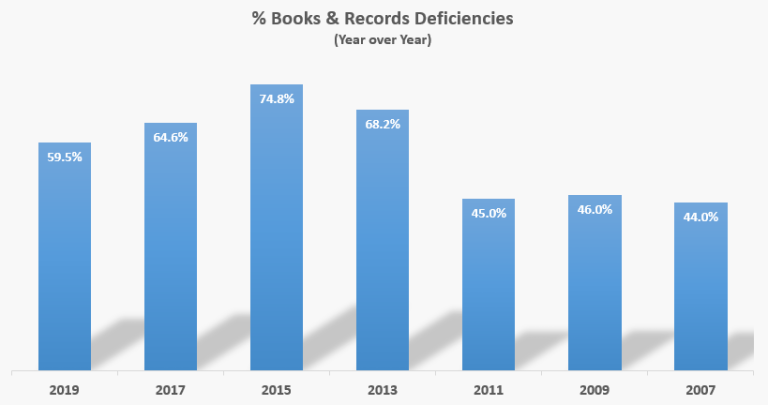The North American Securities Administrators Association (“NASAA”) recently released its 2019 Investment Adviser Coordinated Examinations Report. This report is released on a bi-annual basis and analyzes the findings from adviser examinations and offers best practices. As RIA compliance consultants, we recommend that the Chief Compliance Officer (“CCO”) of all investment advisory firms review the regulatory exam summary report to determine if any changes should be implemented at their firm as a result of the most recent findings.
In this week’s installment of our break-down of the 2019 report, we focus on the most common RIA regulatory compliance deficiency category: books and records. Of the 1,078 investment advisory firms examined in 2019, 59.5% of all firms examined with regulatory assets under management (“AUM”) had at least one books and records-related regulatory deficiency.
Compared to the 2017 report on coordinated state examinations released by NASAA, the overall percentage of firms examined who had at least one deficiency related to books and records has declined slightly from 64% in 2017 to 59.5% in 2019. The greatest increase in books and records deficiencies occurred between 2011 and 2013, with 45% of advisory firms cited for books and records deficiencies in 2011 compared to 68.2% in 2013. The graph below highlights the changes over the last 12 years of reports:

In 2019, the top 5 books and records-related deficiencies were:
- Written agreements: 11.00%
- Trial balances, financial statements: 10.7%
- Client suitability information: 9.4%
- General and auxiliary ledgers: 8.6%
- Disclosure Brochures: 5.3%
In 2017, the top 5 books and records-related deficiencies were:
- Client suitability information: 9.00%
- Trial balances, financial statements: 8.53%
- Written agreements (IA-Client contracts): 8.01%
- General and auxiliary ledgers: 5.97%
- Disclosure Brochures: 3.98%
While books and records issues continue to be the top compliance deficiency among advisory firms examined by state regulators, the most common books and records-related deficiency has shifted from client suitability information (9.0%) in 2017 to written agreements (11.0%) in 2019. In addition, in 2019 the new books and records deficiency titled “No vulnerable persons policies/procedures” appeared on the list of top deficiencies related to books and records with 2.4% of firms cited. Other deficiencies cited by NASAA in the 2019 report include bills and statements, check books/bank statements, advertising file, and no business continuity plan.
